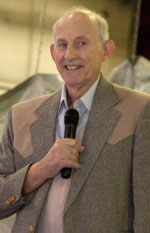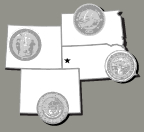Growing Options for Weaned Calves
by Kindra Gordon for Angus Productions Inc.

Terry Klopfenstein shared opportunities for retaining calves profitably.
MITCHELL, Neb. (Nov. 29, 2011) — As the days of “cheap corn” become a thing of the past, the cattle industry must find new options to economically background feeder calves prior to feedlot entry. University of Nebraska-Lincoln animal science professor Terry Klopfenstein highlighted many of those alternatives during his presentation at the Range Beef Cow Symposium XXII in Mitchell, Neb., Nov. 29.
“There are great opportunities for retaining calves to make money out of them," Klopfenstein said. "The goal is to be better than average.” He shared seven important areas for producers to consider as they design a backgrounding plan for their individual operation. The list includes:
- Match cattle to the system you have available. Klopfenstein posed the question, “What fits your resources?” He emphasized that it is a myth to always assume forage gains are cheaper than feedlot gains. He shared data that showed cheap background gains — on forage — lead to expensive feedlot gains. But there are differences in efficiency and the cost of gain. Thus, Klopfenstein says “It is essential to look at the entire system before drawing conclusions about cheap backgrounding gains.”
- Make effective use of grazed forage. As an example, Klopfenstein urged producers to consider the cost of harvesting and feeding forage vs. grazing forage.
- Maximize use of grazed cornstalks. “If available this can be a tremendous resource that can be complemented by feeding byproducts,” Klopfenstein said.
- Use implants and ionophores.
- Make strategic use of byproducts for protein and energy supplementation. Ethanol co-products can be especially cost-effective to minimize supplement costs, he pointed out.
- Optimize pasture management for good cattle gains. Of this, Klopfenstein emphasizes considering the quality of the forage and the time on the forage.
- Sell high. “Be aware of the month you are selling and how you are doing that,” Klopfenstein concluded. He said it is a myth that we can all calve in the spring and produce 1,000 lb. yearlings the next fall. Thus, he said there is a need for backgrounding, particularly on forage, to help supply continuous demand for feedlot replacements.
To view Klopfenstein's PowerPoint, click here.
The biennial Range Beef Cow Symposium was hosted Nov. 29-Dec. 1 at the Mitchell Events Center, Mitchell, Neb., by the cooperative extension and animal science departments of the University of Nebraska-Lincoln, South Dakota State University, Colorado State University and the University of Wyoming. Comprehensive coverage of the event is provided online at www.rangebeefcow.com, an event coverage site provided by Angus Productions Inc. (API), publisher of the Angus Journal and the Angus Beef Bulletin.
Editor’s Note: API's coverage of the event is made available for distribution to all media via an agreement with the Range Beef Cow Symposium Committee and API. Headquartered in Saint Joseph, Mo., API publishes the Angus Journal, the Angus Beef Bulletin, the Angus Beef Bulletin EXTRA, and the Angus e-List, as well as providing online coverage of events and topics pertinent to cattlemen through the API Virtual Library. For questions about this site, or to notifiy us of broken links, click here.

